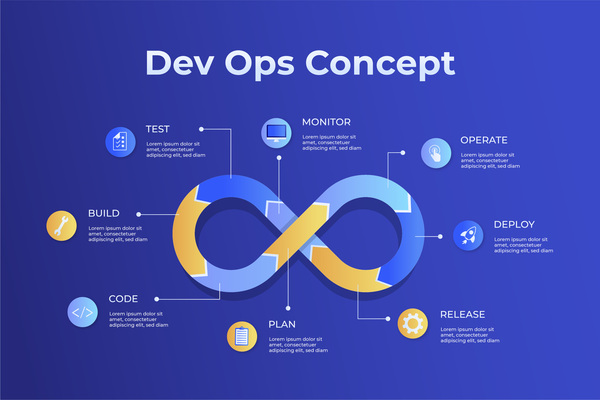Introduction
Hey there, welcome! If you're into software development, you've probably heard a lot about DevOps. It's all about speeding things up and making processes smoother. But today, I want to introduce you to something even cooler: DevSecOps. This concept is all about weaving security right into the fabric of your DevOps process. It's not just an add-on; it's a fundamental part of how we build and deploy software now. Stick with me, and I'll show you why DevSecOps is crucial in today's tech world and how you can start implementing it in your projects.
The Evolution of DevSecOps in Modern Development
Let's start with a quick history lesson. DevOps transformed the way we approach software development by breaking down silos and encouraging collaboration between development and operations teams. But as cyber threats grew more sophisticated, it became clear that security needed to be a part of this equation from the start. Enter DevSecOps, a natural evolution that integrates security into every stage of the development lifecycle. Think of it like upgrading from a regular lock to a smart security system for your house.
Understanding the Key Tenets of DevSecOps
Alright, now let's dig into the core principles that make DevSecOps tick.
Security as Code: Automating Security Practices
First up, we have Security as Code. Imagine having a virtual security guard that's always on duty, scanning for vulnerabilities and issues 24/7. By automating security practices, we can catch problems early and ensure that our code is secure from the get-go. Automation tools can perform static code analysis, run vulnerability scans, and enforce security policies, all without human intervention. It's like having a vigilant watchdog that never sleeps.
Shift-Left Security: Early Detection and Mitigation
Next, let's talk about the Shift-Left approach. This principle emphasizes integrating security measures early in the development process, rather than waiting until the end. By shifting security to the left (i.e., earlier stages), we can detect and mitigate issues before they become major problems. It's like discovering a leak in your boat while it's still docked, rather than when you're already out at sea. This proactive approach saves time, money, and a lot of headaches.
Continuous Monitoring and Compliance
Finally, we have Continuous Monitoring and Compliance. Security isn't a one-time deal; it's an ongoing process. Continuous monitoring ensures that your software remains secure over time by regularly checking for new vulnerabilities and compliance with industry standards. This is crucial, especially in regulated industries where compliance with standards like GDPR or HIPAA is non-negotiable. It's like having a regular health check-up to ensure everything is in tip-top shape.
Implementing DevSecOps in Your Organization
So, how do you bring DevSecOps into your organization? Here are some practical steps to get you started.
Building a Security-First Culture
First things first, you need to build a security-first culture. This means making security everyone's responsibility, from developers to operations to management. Start with training and awareness programs to educate your team about the importance of security and how they can contribute. Encourage a mindset where security is seen as an integral part of the development process, not an afterthought.
Integrating Security Tools and Practices
Next, you'll want to integrate security tools and practices into your development pipeline. Use tools like static code analysis, vulnerability scanning, and security testing to automate security checks. Incorporate these tools into your CI/CD pipeline to ensure that security is continuously assessed and addressed. Think of it as adding multiple layers of protection, much like a multi-layered security system for your home.
Collaboration Between Development, Security, and Operations Teams
Collaboration is key in DevSecOps. Development, security, and operations teams need to work together seamlessly to ensure that security is integrated throughout the development lifecycle. This means breaking down silos and encouraging open communication and collaboration. Use tools and practices that facilitate this collaboration, such as shared dashboards, regular security reviews, and cross-functional training sessions.
Table: Comparison of DevOps and DevSecOps
|
Aspect
|
DevOps
|
DevSecOps
|
|
Focus
|
Collaboration, Automation
|
Collaboration, Automation, Security
|
|
Security Integration
|
Late in the lifecycle
|
Early and continuous throughout
|
|
Primary Goal
|
Speed and Efficiency
|
Security, Speed, and Efficiency
|
|
Culture
|
Development and Operations
|
Development, Operations, and Security
|
|
Tools Used
|
CI/CD, Monitoring
|
CI/CD, Static Analysis, Dynamic Analysis, Vulnerability Scanning
|
|
Compliance
|
Handled separately
|
Integrated into the development process
|
|
Response to Issues
|
Reactive
|
Proactive and Preventive
|
|
Cost of Fixing Issues
|
Higher due to late detection
|
Lower due to early detection
|
Leveraging DevOps Services for DevSecOps
Now, you might be wondering how DevOps services companies fit into all of this. These companies can be invaluable in helping you implement DevSecOps practices effectively.
How Professional DevOps Services Can Enhance Your Security Posture
Partnering with a professional DevOps services can provide you with the expertise and resources you need to enhance your security posture. These companies specialize in integrating security practices into DevOps workflows and can help you identify and address potential security gaps. They bring a wealth of experience and knowledge, ensuring that your security practices are robust and up-to-date. It's like having a team of security experts by your side, guiding you every step of the way.
Final Thoughts
To wrap things up, DevSecOps is all about integrating security into every stage of the software development process. By automating security practices, shifting security checks to the left, and continuously monitoring for issues, you can ensure your software is secure from the ground up. Building a security-first culture, integrating the right tools, and fostering collaboration between teams are key to making DevSecOps work in your organization. And remember, partnering with a professional DevOps services company can give you the expertise you need to enhance your security posture. So, why wait? Start your DevSecOps journey today and take your software security to the next level.
Thanks for sticking with me! If you have any questions or want to share your thoughts, feel free to drop a comment. Let's keep the conversation going!
Frequently Asked Questions (FAQs)
What is DevSecOps?
DevSecOps integrates security into every phase of the software development lifecycle, from initial design through deployment. Unlike traditional methods where security checks happen at the end, DevSecOps ensures continuous security checks, fostering a culture where security is everyone's responsibility.
How does DevSecOps differ from DevOps?
While DevOps focuses on collaboration between development and operations teams to improve software delivery speed, DevSecOps adds a critical security layer. This approach ensures security practices are automated and embedded within the DevOps workflow, reducing vulnerabilities early in the development process.
What are the benefits of adopting DevSecOps?
Adopting DevSecOps leads to faster and more secure software releases. Benefits include early detection of security issues, reduced costs by fixing vulnerabilities early, improved team collaboration, and maintaining compliance with industry regulations.
How can I start implementing DevSecOps in my organization?
Start by fostering a security-first culture where all team members are trained on security practices. Integrate security tools into your CI/CD pipeline for continuous monitoring and automate security checks. Encourage collaboration between development, operations, and security teams to ensure seamless integration of security measures.
What tools are commonly used in DevSecOps?
Common tools in DevSecOps include Static Application Security Testing (SAST) for code analysis, Dynamic Application Security Testing (DAST) for runtime analysis, and tools for vulnerability scanning and automated compliance checks. Popular tools include OWASP ZAP, SonarQube, and Checkmarx.




Comments